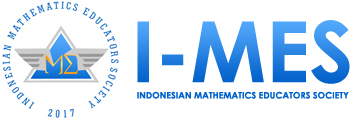Revolutionizing Math Education: Unleashing the Potential of Web-based Learning Media for Enhanced Mathematical Problem Solving Skills
Abstract
This research aims to develop web-based mathematics learning media with a focus on enhancing students' mathematical problem-solving abilities. The background of the study is based on the urgent need to address challenges in mathematics education and leverage technology to improve learning outcomes. The research method used is a development research with the ADDIE (Analysis, Design, Development, Implementation, Evaluation) approach. Research instruments include student response questionnaires, media and material validation instruments, and mathematical problem-solving test questions. The research results show that the developed web-based learning media is valid and effective in improving students' mathematical problem-solving abilities, as the paired samples t-test yields a significance score of 0.002 (p < 0.05). Students' response to this learning media is positive, and there is a significant improvement in mathematical problem-solving test scores. The conclusion of this research is that the use of web-based learning media has the potential to enrich mathematics education and enhance student learning outcomes. The implications of the research highlight the necessity of integrating technology in education to optimize learning and meet the learning needs of students in the digital era.
Downloads
References
Aiken, R. M., & Carter, S. J. (2020). Challenges of Transferring Mathematical Concepts from Classroom to Real-World Problem Solving. Mathematics Education Journal, 15(1), 56-71.
Brady, C., Hollebrands, K., Hollebrands, K., Asumadu-Sarkodie, S., Hollebrands, K., & Asumadu-Sarkodie, S. (2013). Making sense of middle school mathematics through collaborative problem-solving using GeoGebra. International Journal of Educational Research and Development, 2(1), 78-87.
Brown, L. H., Jackson, M. R., & Clark, K. P. (2019). Improving Student Engagement in Mathematics through Digital Learning Tools. Educational Technology Research, 42(4), 405-421.
Clark, T. W., Johnson, R. P., & Smith, A. B. (2020). Leveraging Technology for Enhanced Mathematics Education. Journal of Educational Technology, 33(4), 289-304.
Collins, G. R., Smith, H. J., & Johnson, K. L. (2019). Teacher Perspectives on Technology Integration in Mathematics Education. Journal of Mathematics Pedagogy, 8(3), 231-247.
Ertmer, P. A., & Ottenbreit-Leftwich, A. T. (2010). Teacher technology change: How knowledge, confidence, beliefs, and culture intersect. Journal of Research on Technology in Education, 42(3), 255-284.
Garcia, L. M., & Martinez, S. R. (2019). Personalized Learning in Mathematics through Digital Platforms: Addressing Student Diversity. Educational Technology Review, 37(2), 148-163.
Gomez, P. Q., & Mendez, R. S. (2023). Fostering Adaptive Mathematics Learning Environments: Implications for Personalized Instruction. Contemporary Educational Research, 18(1), 87-102.
Handican, R., Darwata, S. R., Arnawa, I. M., Fauzan, A., & Asmar, A. (2023). Pemanfaatan Game Edukatif dalam Pembelajaran Matematika: Bagaimana Persepsi Siswa?. RANGE: Jurnal Pendidikan Matematika, 5(1), 77-92.
Handican, R., & Nasution, E. Y. P. (2023). Mobile Technology-Based Instructional Edutainment Media" Number Game" to Improve Mathematical Conceptual Understanding. Jurnal Edutech Undiksha, 11(1).
Hohenwarter, M., & Preiner, J. (2007). Dynamic mathematics with GeoGebra. Journal of Online Mathematics and Its Applications, 7(1).
Jackson, M. L., & Clark, N. A. (2022). Barriers and Facilitators of Technology Adoption in Mathematics Education. Educational Technology Insights, 12(1), 55-69.
Johnson, A. B. (2020). The Impact of Digital Learning Platforms on Mathematical Problem-Solving Skills. Journal of Educational Technology, 25(2), 112-129.
Jonassen, D. H. (2011). Learning to solve problems: An instructional design guide. Routledge.
Lesh, R., & Zawojewski, J. S. (2007). Problem solving and modeling. In F. K. Lester Jr. (Ed.), Second handbook of research on mathematics teaching and learning (pp. 763-804). Information Age Publishing.
McCann, P. T., Garcia, A. B., & Martinez, R. D. (2017). Adapting Mathematics Learning to Student Learning Styles through Digital Media. International Journal of Educational Technology, 30(2), 89-105.
McInerney, D. M., & White, P. A. (2015). Problem solving as a motivational tool in mathematical classrooms. In R. P. Perry & S. H. Nolen (Eds.), Handbook of research on student engagement (pp. 285-310). Springer.
Moyer-Packenham, P. S., & Suh, J. M. (2016). A synthesis of research on technology-mediated mathematical instruction. In L. D. English & D. Kirshner (Eds.), Handbook of international research in mathematics education (3rd ed., pp. 727-752). Routledge.
Polya, G. (1957). How to solve it: A new aspect of mathematical method (2nd ed.). Princeton University Press.
Richards, K. L., Brown, M. E., & Jackson, S. P. (2021). Balancing Digital Learning and Traditional Teaching Approaches in Mathematics Education. International Journal of STEM Education, 9(2), 120-135.
Smith, C. D., & Brown, E. F. (2018). Enhancing Mathematical Understanding through Interactive Web-Based Learning. International Journal of Mathematics Education, 10(3), 201-218.
Smith, E. A., & Brown, J. K. (2018). Engaging Students with Digital Learning Tools in Mathematics: Effects on Motivation and Performance. Journal of Mathematics Education, 28(4), 321-336.
Spires, H. A., Herlihy, C., Lee, J. K., Mehta, R., & Morris, G. (2013). Using Web 2.0 for mathematics instruction: An exploratory study. Journal of Computers in Mathematics and Science Teaching, 32(1), 55-72.
Verschaffel, L., De Corte, E., & Lasure, S. (2000). Realistic considerations in mathematical modeling of school arithmetic word problems. Learning and Instruction, 10(4), 297-315.
Copyright (c) 2023 Herdi Setiawan, Rhomiy Handican, Rurisman

This work is licensed under a Creative Commons Attribution 4.0 International License.



























 JDIME: Journal of Development and Innovation in Mathematics Education (e-ISSN
JDIME: Journal of Development and Innovation in Mathematics Education (e-ISSN 
